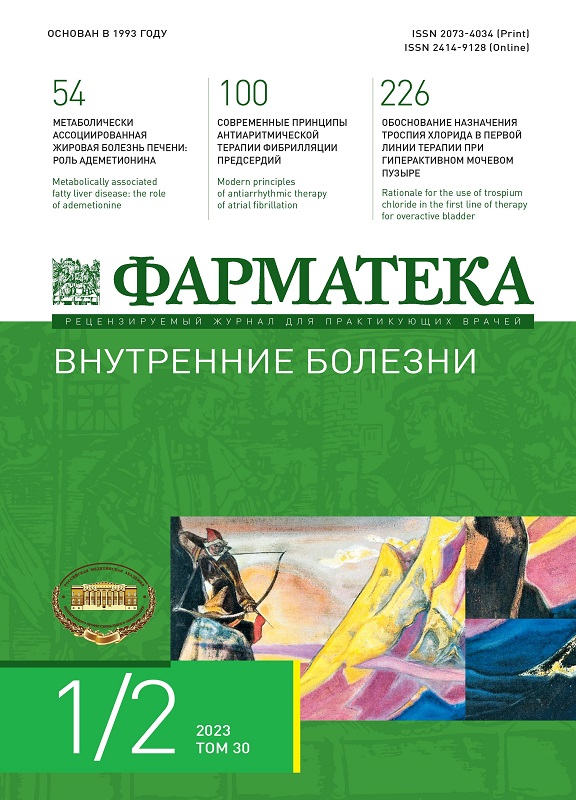Endothelial dysfunction indicators in children with hemolytic-uremic syndrome
- Authors: Makarova T.P.1, Davlieva L.A.2, Melnikova Y.S.1, Khusnutdinova D.R.2
-
Affiliations:
- Kazan State Medical University
- Children’s Republican Clinical Hospital
- Issue: Vol 30, No 1/2 (2023)
- Pages: 221-225
- Section: Urology/nephrology
- Published: 15.06.2023
- URL: https://journals.eco-vector.com/2073-4034/article/view/462812
- DOI: https://doi.org/10.18565/pharmateca.2023.1-2.221-225
- ID: 462812
Cite item
Abstract
Background. Hemolytic-uremic syndrome (HUS) is one of the important causes of acute kidney injury (AKI) in children. An analysis of the literature data demonstrates the central role of endothelial dysfunction (ED) in numerous pathophysiological processes, including in kidney disease. This article discusses the ED indicators (endothelin-1 – ET-1 and nitric oxide – NO) in the blood serum of children with HUS.
Objective. Determination of the clinical diagnostic and prognostic value of ET-1 and NO in blood serum in children with HUS.
Methods. The 2-stage study was carried out. At the first stage of the study, a retrospective analysis of 89 case histories of children aged from 3 months to 17 years with a typical form of HUS (stec-HUS) was carried out. The second stage included a prospective study with participation of 31 children with stec-HUS.
Results. As a result of the determination of the blood serum ET-1 level in patients with stec-HUS in the prospective group, a significant increase in its level in the acute period of the disease and before discharge compared with the data of the control group was revealed (P<0.001); when examined a year later, high blood serum ET-1 level in convalescent children with HUS persisted, which indicates a persistent impairment of the vasomotor function of the vascular endothelium in children with HUS. The results of determination of blood serum NO level in children with stec-HUS, on the contrary, showed a decrease in NO level in the acute stage of the disease and before discharge compared with the control group (P<0.05). When examining convalescent children with-HUS 1 year after, an increase in the blood serum NO level was revealed.
Conclusion. The formation of chronic kidney disease (CKD) after stec-HUS and its progression was accompanied by a significant increase in the ET-1 level and a decrease in the NO level in all studied groups compared with the control group (P<0.05), which indicates a violation of the vasomotor function of the endothelium.
Full Text
About the authors
Tamara P. Makarova
Kazan State Medical University
Author for correspondence.
Email: makarova-kgmu@mail.ru
ORCID iD: 0000-0002-5722-8490
Dr. Sci. (Med.), Professor at the Department of Hospital Pediatrics
Russian Federation, KazanL. A. Davlieva
Children’s Republican Clinical Hospital
Email: makarova-kgmu@mail.ru
ORCID iD: 0000-0002-9816-1309
Russian Federation, Kazan
Yu. S. Melnikova
Kazan State Medical University
Email: makarova-kgmu@mail.ru
ORCID iD: 0000-0001-6633-6381
Russian Federation, Kazan
D. R. Khusnutdinova
Children’s Republican Clinical Hospital
Email: makarova-kgmu@mail.ru
Russian Federation, Kazan
References
- Labonte J., Bkaily G., D`Orleans-Juste P. Endothelin-B-receptors-dependent-inhibition of platelet aggregation in the CD-1 mouse. J Cardiovasc Pharmacol. 2000;34(1):184–86. doi: 10.1097/00005344-200036051-00056.
- Rebholz C.M., Harman J.L., Grams M.E., et al. Association between Endothelin-1 Levels and Kidney Disease among Blacks. J Am Soc Nephrol. 2017;28(11):3337–44. doi: 10.1681/ASN.2016111236.
- Kohan D.E. Role of collecting duct endothelin in control of renal function and blood pressure. Am J Physiol Regul Integr Comp Physiol. 2013;305(7):659–68. doi: 10.1152/ajpregu.00345.2013.
- Saleh M.A., Boesen E.I., Pollock J.S., et al. Endothelin-1 increases glomerular permeability and inflammation independent of blood pressure in the rat. Hypertension. 2010;56(5):942–49. doi: 10.1161/HYPERTENSIONAHA. 110.156570.
- Jin J., Sison K., Li C., et al. Soluble FLT1 binds lipid microdomains in podocytes to control cell morphology and glomerular barrier function. Cell. 2012;151(2):384–99. doi: 10.1016/j.cell.2012.08.037.
- De Miguel C., Pollock D.M., Pollock J.S. Endothelium-derived ET-1 and the development of renal injury. Am J Physiol Regul Integr Comp Physiol. 2015;309:R1071–73. doi: 10.1152/ajpregu.00142.2015.
- Ignarro L.J., Buga G.M., Wood K.S., et al. Endothelium-derived relaxing factor produced and released from artery and vein is nitric oxide. Proc Natl Acad Sci.1987;84(24):9265–69. doi: 10.1073/pnas.84.24.9265.
- Cyr A.R., Huckaby L.V., Shiva S.S., Zucker- braun B.S. Nitric Oxide and Endothelial Dysfunction. Crit Care Clin. 2020;36(2):307–21. doi: 10.1016/j.ccc.2019.12.009.
- Martens C.R., Edwards D.G. Peripheral vascular dysfunction in chronic kidney disease. Cardiol Res Pract. 2011;2011:1–9. doi: 10.4061/2011/267257.
- Schmidt R.J., Baylis C. Total nitric oxide production is low in patients with chronic renal disease. Kidney Int. 2000;58(3):1261–66. doi: 10.1046/j.1523-1755.2000.00281.x.
- Schmidt R.J., Yokota S., Tracy T.S., et al. Nitric oxide production is low in end-stage renal disease patients on peritoneal dialysis. Am J Physiol-Ren Physiol. 1999;276(5):F794–97. doi: 10.1152/ajprenal.1999.276.5.F794.
- Bohm F., Pernow J. The importance of endothelin-1 for vascular dysfunction in cardiovascular disease. Cardiovasc Res. 2007;76(1):8–18. doi: 10.1016/j.cardiores.2007.06.004.
- Catar R., Moll G., Kamhieh-Milz J., et al. Expanded Hemodialysis Therapy Ameliorates Uremia-Induced Systemic Microinflammation and Endothelial Dysfunction by Modulating VEGF, TNF-α and AP-1 Signaling. Front Immunol. 2021;12:774052. doi: 10.3389/fimmu.2021. 774052.
Supplementary files









